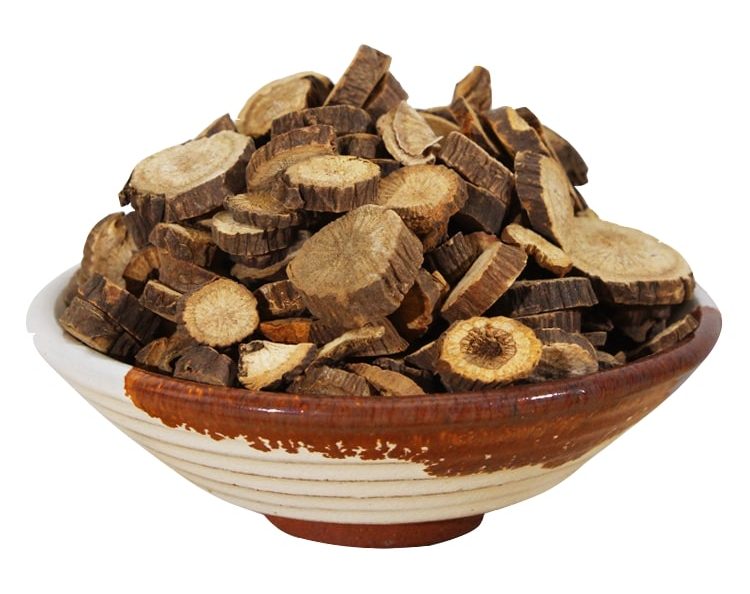Red Peony Root (Chi Shao)

What is Red Peony Root (Chi Shao)?
Red Peony Root (chi shao, 赤芍) is the rhizome of Red Peony, the national flower of China during the Qing dynasty. Also known as Paeoniae Rubra, the Ranunculaceae plant is produced in most parts of China. These medicinal roots are usually harvested in Spring and Autumn. After the removal of fibrous roots and dirt, the roots are dried under the Sun, sliced and then used in both crude and fried forms.
It is believed that Red Peony Root (Chi Shao) contains a unique compound called paeoniflorin, which is believed to calm the nerves and reduce the incidence of muscle spasms. In animal tests, Red Peony extracts have also stopped blood platelets from clumping, although these tests have yet to be replicated in humans. Other tests have shown that red peony can help patients with viral hepatitis.
In Traditional Chinese Medicine (TCM), Red Peony Root (Chi Shao) falls under the category of ‘Herbs that invigorate the blood‘. This herb can help the circulation of blood in cardiovascular conditions or menstrual irregularities, and to treat acute pains caused by Blood Stagnation.
Cool in nature, Red Peony Root (Chi Shao) can help individuals who have too much Heat in the body, such as those experiencing a Yang Excess or a Yin Deficiency, to restore a healthy yin-yang balance. Bitter in taste, the herb can cleanse the body by clearing Heat, dry Dampness and promote elimination via urination or bowel movements. In particular, Red Peony Root targets the Liver.
Functions and Benefits of Red Peony Root (Chi Shao)
According to TCM, it is believed that Red Peony Root (Chi Shao) has the following health benefits:
Red Peony Root (Chi Shao) can clear Heat and cool blood. It treats Heat entering nutrient-blood manifested as macular, papule and hematemesis. Also, Red Peony Root can be combined with other Heat-clearing and toxicity-removing herbs to reinforce its impact in stopping bleeding and resolving Blood Stasis.
By activating blood to resolve Stasis, the herb also excels in stopping pain caused by Blood Stasis. Red Peony Root can treat the syndrome of Stagnation caused by Blood Heat, and can treat Stagnation caused by congealing Cold when combined with meridian-warming, Cold-dispelling or blood-activating herbs. Hence, Red Peony Root can be used to treat syndromes of blood stasis such as irregular menstruation, endometriosis, dysmenorrhoea, amenorrhoea, abdominal mass, pelvic inflammatory disease, traumatic injury with swelling pain, ulcer, abscess, dysentery, abdominal pain and numbness in hands.
Also, Red Peony Root (Chi Shao) can clear Liver Fire to treat blood-shot eyes with swelling and pain, as well as photophobia with profuse eye secretion. It is often combined with Liver fire-clearing and vision-improving herbs.
Modern studies have shown that Red Peony Root (Chi Shao) can expand the coronary arteries and increase coronary blood flow. The paeoniflorin that it contains also has sedative, anti-inflammatory and analgesic effects, which makes Red Peony Root (Chi Shao) a great herb to treat symptoms such as insomnia and diseases caused by oxidative stress. The herb also has anticonvulsant effects and antispasmodic effects. In addition, Red Peony Root (Chi Shao) has a strong inhibitory effect on a variety of pathogenic microorganisms.

How to Use Red Peony Root (Chi Shao)
The recommended dosage of Red Peony Root is 1 – 3g, when in capsule form and consumed three times per day. When used in decoction, Red Peony Root is usually used in doses of 6 – 12g.
Red Peony Root is available in ready-to-consume forms such as powder, extract, capsules and other forms of supplements. Red Peony Root is often cooked in boiling water to make tea or soup for consumption too.
Cautions and Side Effects of Red Peony Root (Chi Shao)
Red Peony Root (Chi Shao) should not be used by individuals experiencing a Blood Deficiency. Also, as some research has suggested that Red Peony Root (Chi Shao) can cause uterine contractions, pregnant and breastfeeding ladies should avoid this herb for the time being. In addition, Red Peony Root may cause rashes when it comes in contact with the skin of sensitive individuals.
Because Red Peony Root (Chi Shao) may slow down the process of blood clotting, there are concerns that the herb might increase the risk of bleeding in individuals with bleeding disorders and the risk of bleeding during and after surgeries. Hence, individuals with bleeding disorders and individuals who have a scheduled surgery in 2 weeks should avoid consuming this herb.
For the same reason, individuals consuming medicine that slows down blood clotting, such as anticoagulant and antiplatelet drugs, should avoid consuming Red Peony Root too.
Summary
Here is a summary for Red Peony Root (Chi Shao):
- Herb name (Chinese): 赤芍
- Herb name (Pin Yin): chì sháo
- Herb name (English): Red Peony Root
- Herb name (Botanical): Radix Paeoniae Rubra
- Origin of species: Paeonia lactiflora Pall.; Paeonia veitchii Lynch
- Part(s) of herb used: Root
- Geo-specific habitat(s): Most parts of China
- Taste(s) & Properties: Bitter; Slightly cold; Administrates the Liver Meridian
- Actions: Remove blood stasis, and relieve heat in blood; Relieves menstrual pain or pain resulting from external injuries; Eases body rashes and painful eyes
References
Liu, B. S., Miao, M. S., & Peng, M. F. (2018, February). Medicinal Value Analysis of Peony Flower. In 2017 2nd International Conference on Biological Sciences and Technology (BST 2017) (pp. 320-326). Atlantis Press. [Accessed on 15th November 2022]
Shi, Y. H., Zhu, S., Ge, Y. W., He, Y. M., Kazuma, K., Wang, Z., … & Komatsu, K. (2016). Monoterpene derivatives with anti-allergic activity from red peony root, the root of Paeonia lactiflora. Fitoterapia, 108, 55-61.[Accessed on 15th November 2022]
Zhu, S., Yu, X., Wu, Y., Shiraishi, F., Kawahara, N., & Komatsu, K. (2015). Genetic and chemical characterization of white and red peony root derived from Paeonia lactiflora. Journal of natural medicines, 69(1), 35-45.[Accessed on 15th November 2022]
Share this article on
